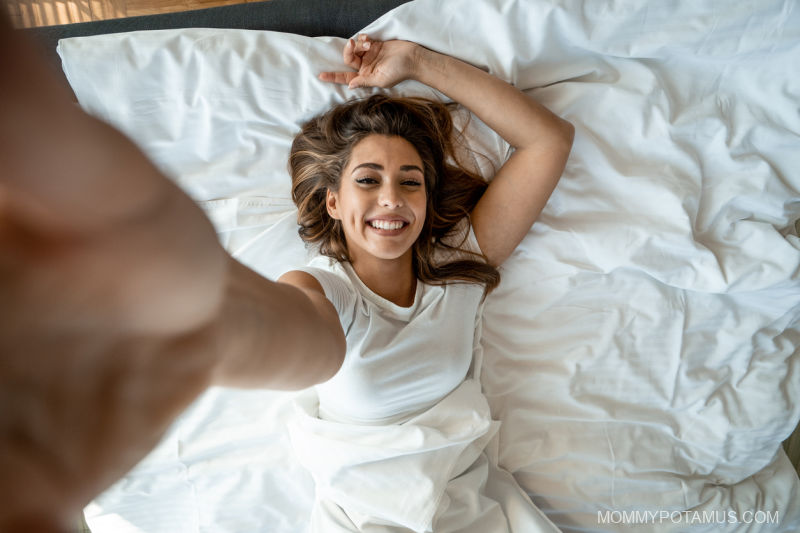
Inside: 22 science-backed sleep tips for deeper, more restful zzz’s that work even if you have kids!
What do the theory of relativity, Google, and a Nobel prize have in common? Why, they were all discovered or inspired by dreams of course! Sleep may not solve everything, but it sure solves a lot. Unfortunately for most of us, getting enough sleep can be, er, challenging to say the least.
Maybe, like me, you went into the whole parenting gig thinking that the phrase “sleep like a baby” indicated actual sleep was going to be had by all. You might even have taken some optimistic sleep/snuggle photos when your sweet babe arrived . . .

. . . followed by some, um, more realistic ones . . .

Studies show that sleep makes us smarter, more creative, happier, more productive, and it even keeps us looking younger, so how do we get deep, restorative zzz’s when circumstances are not ideal? (1) (2) (3) (4 ) (5) (6)
As a mama of three, I’ve done quite a bit of research on this subject, and my entire family’s sleep quality has improved as I’ve implemented what I’ve learned. Here’s what I’ve found most helpful:
1. Get Sunlight First Thing In The Morning
Our circadian rhythms – which orchestrate the ebb and flow of cortisol and melatonin – are tied to light and darkness. Cortisol helps us get going in the morning, and melatonin tells our body when it’s time to wind down for bed. Problem is, most of us are out of sync.
To get back on track, we need to spend 15-30 minutes in bright sunlight early in the morning. In one study, workers who got regular sunlight tended to be more physically active during the day and got more sleep at night. They were also found to be generally happier and reported fewer health problems, which is a nice bonus.
Although the workers in that particular study got light throughout the entire day, other research indicates that early morning light produces the best effects. (7) (8)
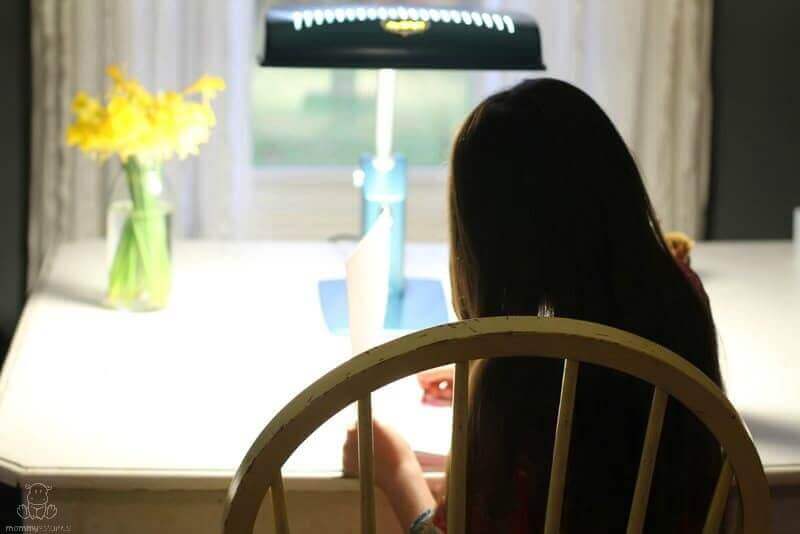
Sleep Hack #1: Indoor Bright Light
If you don’t roll out of bed, yawn daintily like Julie Andrews, and then go out in your front yard to sing about how the hills are alive with the sound of music, that’s okay. You can still get the benefits of early morning light.
These days my schedule allows for an early morning walk, but a few years ago going outside for 15-30 minutes of sun just wasn’t practical for my family most mornings. To get the benefits of early morning light I bought this daylight lamp and put it on the kitchen table while my kids worked on art projects or home school assignments. My plan was make breakfast and then join them for half an hour or so while planning my day, but I felt frustratingly tethered to my chair and stopped doing it.
Later, I invested in these space-age looking blue/green light glasses, which allowed me to move around the house while receiving light therapy. Within a few days of using them I was able to think clearly and feel focused for long stretches of time instead of short bursts.
They’re CNN’s #1 gift pick for travelers, have been featured in Forbes, and were developed by a university – here’s a full review of them, and you can also find them here.
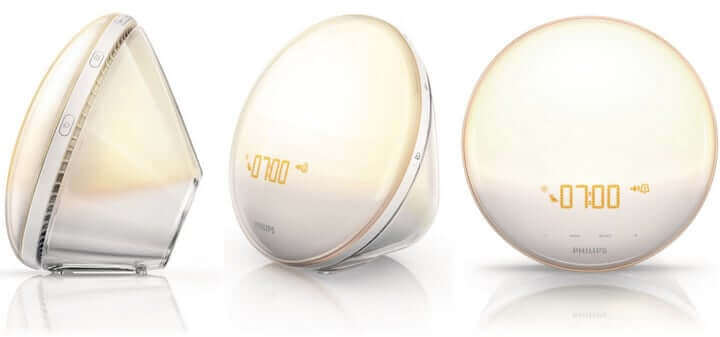
Another option is this wakeup light, which simulates sunrise in your bedroom. It was developed by Phillips, who:
carried out extensive research with leading light therapy experts into the relationship between light and well-being. That research showed a positive correlation between dawn simulation and how people feel when they wake up. Waking up to gradual light, like a sunrise, is hard-wired into the human brain.
As light falls on a person’s eyes, a message is sent to their brain that stimulates production of cortisol, known as the energy hormone. Waking up to dawn simulation has also been proven to help keep a person’s internal body clock in sync. It helps to regulate our circadian rhythm, promoting better sleep and reduced stress levels – unlike waking up in the dark to a sudden noise like a traditional alarm clock.” (9)

2. Avoid Blue Light At Night
We need sunlight during the day to keep our circadian rhythm on the right track, but sunlight at night? Now, that’s just downright confusing to our bodies.
Unfortunately, computer screens, t.v.’s, smartphones and even regular light bulbs emit blue light, which the body perceives like sunlight. According to some studies, blue light exposure after sundown can suppress the release of melatonin, which tells our body it’s almost time for bed.
That’s not all it does, though. Melatonin is vital for health, and low levels can cause more problems than just a rough night’s sleep. According to Chris Kresser L.Ac , low melatonin levels have been:
“shown to increase the risk of cancer, impair immune system function, and possibly lead to cardiometabolic consequences such as type 2 diabetes, metabolic syndrome, obesity, and heart disease. (11, 12, 13) With serious consequences like these, preventing melatonin suppression should be a top priority in anyone’s healthy lifestyle.”
Unfortunately, although melatonin supplements may have some benefits they also have potential side effects, especially when used long-term. One expert called their use with children “rather alarming” due to the potential for long-term effects. You can read more about melatonin supplements for sleep here.
But what’s that – you’re not ready to give up screen time after the kids go to bed? Yeah, me neither, and for that matter I’m not going to turn off all the lights and sit in darkness either. Fortunately, there are ways to reduce blue light exposure anyway, and research has shown them to be very effective. (10) (11)
Sleep Hack #2: Block The Blue
Here are three tips for reducing blue light at night:
- Bright light suppresses more melatonin than low level light, so dim the lights in your house around sunset. I also dim my computer screen, but that’s optional.
- To block blue light coming from ambient lights and my t.v. screen, consider wearing amber-hued glasses at night. Uvex sells a very inexpensive version, but they scratch easily and can make the screen seem a little fuzzy while watching movies or shows. After using them for a long time I finally found these – screens appear crisp and clear with them on, they’re affordable, and they’re more comfortable, too!
- Install F.lux – It’s a free software that removes blue hues from your computer screen at night. Download it here.
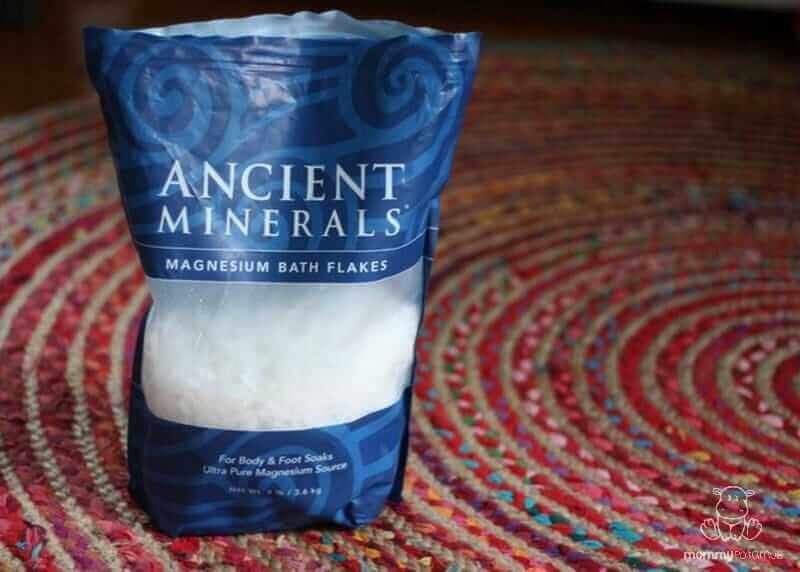
3. Optimize Your Levels Of This “Miracle Mineral”
Magnesium fuels about 300 biochemical reactions in the body. In addition, it helps to relax achy muscles, mitigate the effects of stress, and calm the mind by supporting the production of the neurotransmitter GABA.
Sleep problems are often a symptom of magnesium deficiency. We’re not exactly sure why, but we do know that this “miracle mineral” relaxes achy muscles, and calms the mind by assisting with the production of the neurotransmitter GABA and mitigates the effects of stress, so that may be part of it.
This study also suggests that magnesium may improve sleep quality by increasing melatonin levels and decreasing cortisol levels.
How To Improve Your Magnesium Levels
The best way to get magnesium is through food, because whole foods come with cofactors that help with nutrient absorption. Unfortunately, due to soil depletion and factors such as stress which increase our need for magnesium, it’s difficult to get all we need from food.
Here’s a guide to magnesium supplementation and here’s a bath salts recipe that can help improve levels.
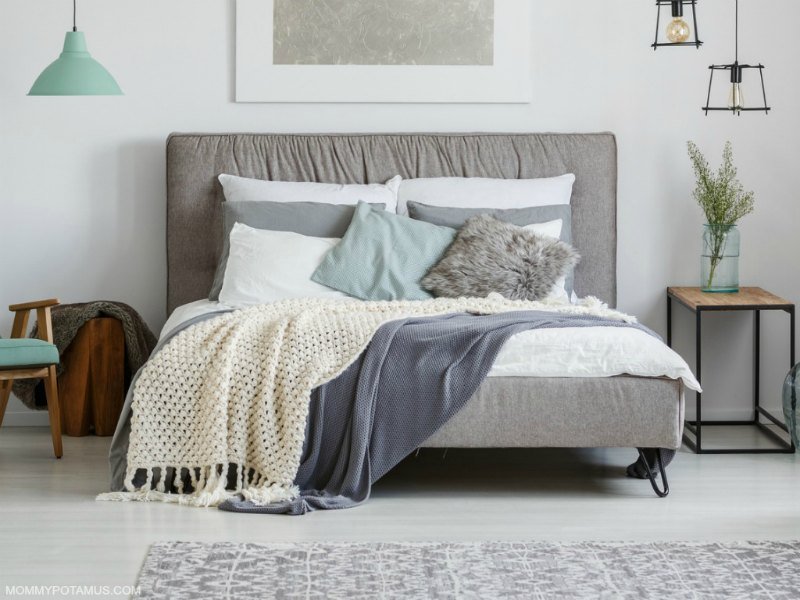
4. Sleep On A Good Mattress
Duh, right? But seriously, this makes a huge difference. When we sleep on an uncomfortable bed it creates pressure on our hips, back, and shoulders, and we have to move frequently to redistribute our weight. If we don’t, areas under pressure lose circulation and tissue gets damaged. According to the Mayo Clinic, ”Bedsores — also called pressure sores or pressure ulcers — are injuries to skin and underlying tissue resulting from prolonged pressure on the skin.”
Obviously, our bodies do whatever it takes to prevent this damage from happening. Since we don’t typically move around while remaining in Stage 3 and 4 sleep, we have to come up out of that deep, restorative sleep back into lighter sleep to shift our weight. These “micro-arousals” may inhibit or stop the release of human growth hormone during deep sleep. (12)
In other words, frequently shifting our weight during sleep may prevent us from getting adequate amounts of deep, restorative sleep.
My favorite non-toxic mattress company has solved this problem by creating a mattress that is both soft (for pressure relief) and firm (for proper spinal alignment). I know, it’s always been an either/or choice, but their solution is the real deal.
They have a 60 day, risk-free trial, so if you’re interested in trying them you can have a bed delivered to your door, worry-free. If you decide it’s not for you they will pay to have it shipped back to them. (You do have to pay for shipping to your house and use a mattress protector during the trial period if you think you might want to return it, but if you love yours half as much as I love mine you won’t even consider it.)
Click here to read about why I love intelliBED.
5. Give Aromatherapy A Try
In this small study, lavender essential oil placed in a diffuser improved quality of sleep for individuals who suffer from mild insomnia, and in this study it increased deep, slow-wave sleep in both men and women.
Here’s how I use it in my routine:
Aromatherapy For Better Sleep
My personal preference is to place a relaxing blend (like lavender, mandarin, ylang ylang, valerian and neroli) into a diffuser right before bed.
A good rule of thumb is diffuse for 30-60 minutes, then take an hour off, then repeat if desired. Many diffusers have a timer that you can set to shut off automatically. This one is on my wish list – it has an interval mode that allows it to run 10 minutes on/20 minutes off for up to 21 hours.

6. Get Grounded
A practice called “earthing” is thought to help regulate our hormonal ebbs and flows with a mechanism similar to early morning light. In a study conducted by Ghalv, M.D. and Dale Teplitz, M.A, earthing reduced overall levels of cortisol and fine-tuned the secretion cycle so that levels were highest in the early morning, which is when it’s most needed.
To practice earthing, all you need to do is go outside. Read more about it here.
7. Set A Caffeine Curfew (And Stick To It)
Caffeine has a life of it’s own – a half-life, that is. Sip that cuppa joe (with 200mg of caffeine) at 3pm, and chances are pretty good that 100mg will still be active in your system at 9pm. Everyone metabolizes caffeine at a different rate, so do some experimenting and find out when your cutoff point should be. (13)

8. Avoid Light Pollution
So, the irony of the above photo is in order to avoid the problems associated with too much light at night, we need to do more than cover our eyes. We now know that our skin senses light in ways we used to think only the eyes could, so light can disrupt our circadian rhythm even when we’re wearing a mask.
Blackout curtains are a much better option, and they don’t just come in black. Check out some of the colors that are available here.
Also make sure to cover any lights on your alarm clock or other electronic devices.
9. Chill Out
“’When you go to sleep, your set point for body temperature — the temperature your brain is trying to achieve — goes down,’ says H. Craig Heller, PhD, professor of biology at Stanford University, who wrote a chapter on temperature and sleep for a medical textbook. ‘Think of it as the internal thermostat.’ If it’s too cold . . . or too hot, the body struggles to achieve this set point.” (14)
Experts say the ideal sleep environment for most people is between 65-72F, so find what works for you. I recommend wearing loose, light pajamas to bed so you don’t overheat.
However, if you find that you’re having trouble sleeping because your feet are cold, put on a pair of warm socks. According to this article, research shows that as you get sleepy, your “body’s temperature regulation system redistributes heat from your core to your extremities. Having cold feet demands more from this system and upsets the natural release of melatonin, a hormone related to a proper sleep-wake cycle.”

10. Let The List Go (Just For A Little While)
Do you feel overwhelmed by “to do” lists or other distractions at night? A handful of studies show that meditation and/or relaxation can help you let go and relax. I’ve found deep breathing throughout the day to be helpful, and I also love to listen to relaxing music and/or podcasts while winding down at night.
11. Flex Your Muscles
Though it can take up to four months, regular exercise may lengthen the amount of time we sleep while and improve overall sleep quality. (source) Based on the study, I’m aiming for 30 minutes at least three or four times a week.
Though I confess I don’t always work it in, my two favorite types of exercise are rebounding and kettlebells. I use this rebounder, which doubles as a playground for my kids when it’s too cold to play outside. (It also folds in half, which I like because I can store it under my bed.) I also have this kettlebell in a few different weights ranging from 8-20 pounds.
12. Sip Don’t Slurp
Though alcohol can sometimes help with falling asleep, it actually hurts overall sleep quality by disrupting normal sleep patterns. (15) Researchers are not exactly sure why that is, but some theorize that it has to do with the inhibition of melatonin secretion and/or its ability to cause spikes in blood sugar that jolt us wide awake at 2am.
Whatever the reason, if I opt for a big girl beverage (like this this hot buttered rum or spiked eggnog), I make sure to enjoy it early in the evening so that it doesn’t interfere with my sleep. And of course, I sip rather than slurp. 
13. Brew Sleepy Tea
Brew up a relaxing herbal tea like chamomile or kava kava, which studies suggest may help with falling asleep. (16) (17)
14. Take A Warm Bath
While our bodies are designed to sleep best in a relatively cool environment (usually 65-72F), a warm bath or shower before bed can a facilitate good night’s sleep.
When your core temperature drops at night, it triggers the release of melatonin and signals to the brain, ‘Time to get sleepy.’ ‘A hot-water immersion will cause blood flow to the extremities (notice how your skin gets flushed after a Jacuzzi or a sauna?) and away from your vital organs, lowering your core body temperature and encouraging sleepiness.” Michael J. Breus, Ph.D., author of The Power of When.
According to this study, a hot bath taken 1.5 hours before bed decreased sleep fragmentation in older adults suffering from insomnia.
15. Try Pink Noise
Want to do a little experiment? Listen to the clip above for just sixty seconds, and then read on. (Seriously, try it. It’ll be fun.)
Are you thinking, “Whoa, what was that?” Good! It’s called pink noise, and it’s essentially white noise that has been filtered to be less harsh.
Researchers think it helps with sleep because the “steady drone of pink noise slows and regulates your brain waves, which is a hallmark of super-restful sleep.” (18)
In this German study, “pink noise appeared to prolong deep sleep and to increase the size of the subject’s brain waves during that period, as evinced by their EEGs.” According to the writeup, “The slow brain waves that characterize deep sleep are implicated in information processing and memory formation, and sure enough, on the mornings after those brain waves appeared to have been enhanced, the participants remembered a higher number of word pairs (an average of 22, as opposed to 13).”
In another study conducted by Jue Zhang, Ph.D., an associate professor at China’s Peking University, “An impressive 75% of study participants reported more restful sleep when exposed to pink noise. When it came to brain activity, the amount of “stable sleep”—the most restful kind—increased 23% among the nighttime sleepers exposed to pink noise, and more than 45% among nappers.” (18)
How To Incorporate Pink Noise For Deep Sleep
“To experience the benefits of pink noise in your own bedroom, Zhang recommends fans or noisemakers that produce steady, uninterrupted sound or that imitate falling rain or wind,” writes Prevention Magazine. You can also try Sleep Genius, which I wrote about here.
16. Respect The 10-2 Window
I recently heard Dr. Alan Christianson – author of the upcoming book The Adrenal Reset Diet – say at a small gathering that our bodies are hardwired to do most of their intensive healing/repair work between the hours of 10pm-2am. This may be because in more primitive environments, this window of time is the safest for us to be out of commission.
Remember, we don’t move in the deeper stages of sleep, so we’re more vulnerable. It’s probably best to get that kind of sleep out of the way while predators are still groggy from waking up for their “day,” so that when predators are fully awake and prowling we can run away if needed.
Another interesting phenomenon Dr. Christianson mentioned was the second wind. Have you ever been so done with a day that you were ready to go to bed at 6pm, only to find yourself wide awake and scanning Facebook at 10:30 pm later on? Chances are, your body released hormones intended for intensive repair (aka beauty sleep), but because you hadn’t gone to bed yet you experienced it as an energy rush instead.
Now that I know what the second wind is, I try to avoid it, and I’ve noticed it makes a big difference for my adrenal health. I want all those lovely hormones to repair my body and help me feel good, not keep me up watching cat videos.
17. Turn Off Wifi At Night
In his book, Overpowered, Dr. Martin Blank of Columbia University argues that EMF exposure is having a profoundly negative effect on our bodies, especially when it come to DNA repair. Dr. Blank doesn’t recommend complete avoidance, but suggests instead that we take precautions with them just like we do with other activities – like wearing seat belts while driving.
Since much of our most important DNA repair activities happen while we sleep, it may be wise to turn off sources of intense EMF exposure during that time.
Note: In addition to turning off wifi, I would also keep cell phones out of the bedroom. However, if it was absolutely necessary to keep it nearby I would put it in airplane mode.
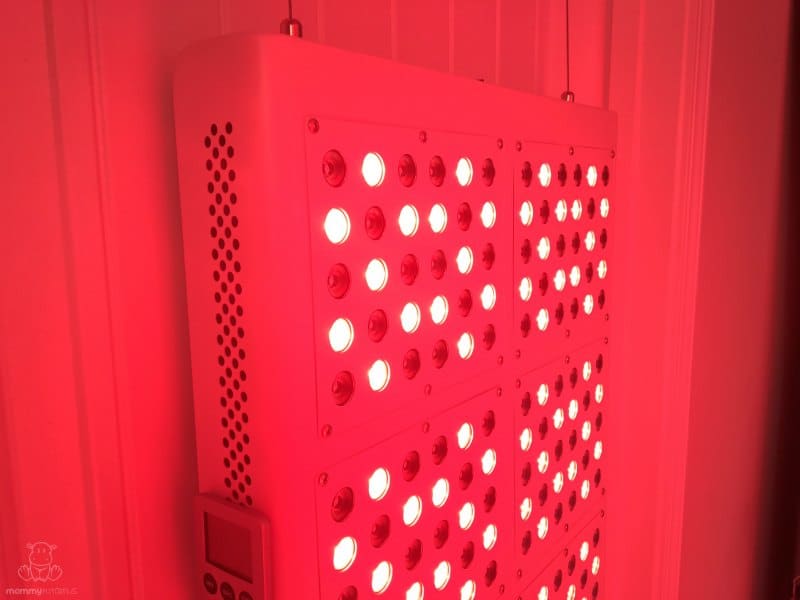
18. Try Red Light Therapy
In this study, female athletes who received red light therapy at night had higher levels of melatonin than those who did not.
19. Fast 3 Hours Before Bed
According to Dr. Breus: “Eating within three hours of bedtime – late-night snacking – sends blood and heat to your core, which is a signal to the body to stay awake.” (19)
This was a really, REALLY hard habit for me to break, but I’ve found that I wake more rested when I do. Also, interestingly, our bodies have higher levels of insulin in the evening. Insulin is a hormone that tells our bodies to store food as fuel (aka fat), which means that food consumed late in the evening is more likely to be stored as fat rather than used as fuel.
20. Try Savasana Pose
Relaxing yoga poses are correlated with higher levels of melatonin according to this study.
21. Meditate
The brain responds to calming practices by releasing melatonin, as is evidence by this study (and this one, and this one). I’m not good at meditating in the traditional sense, but my bedtime routine sometimes includes things that have a similar effect. Coloring, for example, can have a similar neurological effect to meditation/relaxation practices.

22. Drink Cherry Juice
According to one study, adults suffering from insomnia slept an average of 84 additional minutes after consuming tart cherry juice two times per day for two weeks. Some parents rave about cherry juice as a children’s sleep aid, including my friends Genevieve of Mama Natural and Cara of Health Home & Happiness.
Ideally, the cherry juice would be consumed during the day, not within the three-hour window before bed.
This article was medically reviewed by Dr. Scott Soerries, MD, Family Physician and Medical Director of SteadyMD. As always, this is not personal medical advice and we recommend that you talk with your doctor.
What tips and tricks for getting good quality sleep have you found most helpful?
Sources:
1. Scientific American (2008) Sleep On It: How Snoozing Makes You Smarter. Retrieved from https://ift.tt/32yFOuG
2. PBS (2012) Can Sleep Make You Smarter? Retrieved from https://ift.tt/2O59JaC
3. BBC (2013) How Sleep Makes Your Mind More Creative. Retrieved from https://ift.tt/1aF3kT7
4. American Psychological Association (2014) More Sleep Would Make Most Americans Happier, Healthier and Safer. Retrieved from https://ift.tt/2O42xM1
5. Stump, Scott (2013) “Nap Rooms” Encourage Sleeping On The Job To Boost Productivity. Retrieved from https://ift.tt/32zcfZL
6. Harris, Shelby (2013) Sleep and Longevity: 5 Ways Sleep Keeps You Young. Retrieved from https://ift.tt/2O4Bmk3
7. Northwestern University (2014) Morning Rays Keep Off The Pounds. Retrieved from https://ift.tt/2y7Ltc9
8. Dodson, Ehren and Zee, Phyllis (2010) Therapeutics for Circadian Rhythm Disorders. Retrieved from https://ift.tt/2LxmNDD
9. Phillips Company. Waking Up To Sunrise. Retrieved from https://ift.tt/2SzUqW8
10. Burkhart, K and Phelps, JR (2009) Amber lenses to block blue light and improve sleep: a randomized trial. Retrieved from https://ift.tt/2fpbudj
11. Sasseville, A et. al. (2006) Blue blocker glasses impede the capacity of bright light to suppress melatonin production. Retrieved from https://ift.tt/2oLcK22
12. Cline, John (2010) The Mysterious Benefits of Deep Sleep. Retrieved from https://ift.tt/2LxmOrb
13. Mandal, Ananya. Caffeine Pharmacology. Retrieved from https://ift.tt/2SwRvgP
14. WebMD. Can’t Sleep: Adjust The Temperature. Retrieved from https://ift.tt/2D7Q9EQ
15. Rupp, TL et. al. (2007) Evening alcohol suppresses salivary melatonin in young adults. Retrieved from https://ift.tt/2juepb0
16. Srivastava, Janmejai et. al. (2010) Chamomile: A herbal medicine of the past with bright future. Retrieved from https://ift.tt/2cr6IhJ
17. Shinomiya, K et. al. (2007) Effects of kava-kava extract on the sleep-wake cycle in sleep-disturbed rats. Retrieved from https://ift.tt/2SsHroY
18. Heid, Markham (2012) The Noise That Will Help You Sleep Better. Retrieved from https://ift.tt/2Lvl8i1
19. Breus, Michael (2016) The Power of When.
Continue reading How To Sleep Better: 22 Science-Backed Tips...
from Mommypotamus https://ift.tt/2SrnWgG
 Reviewed by Unbelievable Tamil Facts
on
July 21, 2019
Rating:
Reviewed by Unbelievable Tamil Facts
on
July 21, 2019
Rating:



No comments: